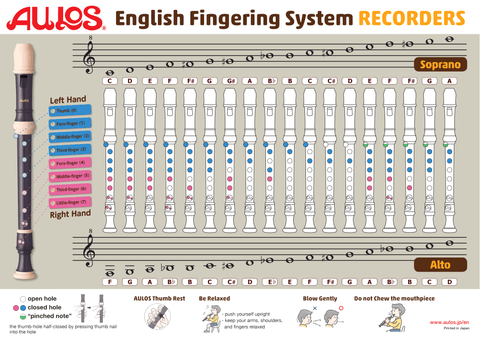History of the Recorder
The recorder originated in Europe in the 14th century and was a popular instrument during the Middle Ages, Renaissance and Baroque periods.2 A member of the flute-family, the recorder is recognised by its whistle mouthpiece (also known as a fipple), seven finger holes on the front of the instrument, and a thumbhole on the back. Traditionally recorders were crafted from single pieces of wood or occasionally from ivory. Renaissance recorders were designed to be played in groups, known as consorts, of different sized recorders that blended well together.3
In the seventeenth century, the recorder, along with other woodwind instruments, was altered to become what we know today as the Baroque recorder – an instrument in three sections with a tapering or conical bore.3 After the Baroque period the recorder experienced a decline in popularity and for about 150 years no music was written for it. In the 20th Century, specifically in the UK and Germany, a revival of baroque music resulted in the recorder being rediscovered.
Today recorders come in a variety of sizes and pitches: the tiny Garklein recorder, the sopranino the Soprano (or descant), the Alto ( or treble), the Tenor, the Bass and the Contra-bass. The four most commonly played recorders are soprano, alto, tenor, and bass which correspond to the four principal voice parts.

Recorders as an instrument for Music Education
In the 1900s Carl Orff, a German composer, developed an elemental approach to music and dance education, he wanted melodic instruments to include in the percussion ensemble.4 Orff established teaching methods that focused on rhythm, movement, and creative thinking to make learning the basic principles of music theory more enjoyable for young children.2 Orff and his colleague Gunild Keetman decided to include the recorder in their approach, now know as Orff Schulwerk. With the exception of the human voice, the recorder is the only non-percussive instrument in the Orff ensemble.4
Today, recorders are used to introduce young children to music theory, as well as, the experience of playing in an instrumental ensemble.4 Due to its easy-to learn nature and suitability for small hands the recorder is the ideal introductory instrument. It allows young children to practice coordination, develop finger dexterity and improve creative thinking.2
Aulos Recorders
Like many other parts of the world, recorders were introduced into the Japanese school curriculum in the 1950s. Toyama Musical Instrument Co was established in 1954 and has been manufacturing high quality ABS resin recorders ever since. The name “AULOS” derives from ancient Greek meaning a wind Instrument with double reed.
Aulos Recorders are currently used in schools in over 50 countries worldwide and are known for their high quality, durability and excellent intonation throughout the full range of instruments. The Aulos brand is built on a legacy of Japanese craftsmanship which is continually developing techniques and methods to maintain and improve performance, quality and consistency in its instruments.6 Polliacks Music is proud to be the leading supplier of Aulos recorders in South Africa.
Aulos Technology - The design features that make Aulos recorders unique

Learn more about the full range of Aulos recorders here: http://www.aulos.jp/en/products.html
Fingering Systems
Aulos recorders use the original Baroque (or English) fingering system created in 1919 By Arnold Dolmetsch. It is the most common system and is used by most music educators. The alternative is German fingering, developed in 1930 as a ‘simplified’ system, however it is not very popular. A German style recorder can be identified by the smaller finger hole in the third position above the bell.6

Interesting facts about Recorders
In many European languages, the word for recorder was the same as the word for flute.
King Henry VIII was an avid amateur musician and by the end of his life owned seventy-six recorders.3
Unlike other wind instruments – such as the oboe or clarinet - there was very little music written for recorders during the Classical and Romantic periods, as a result, recorders are not often included in an orchestra.
The worlds’ largest recorder is 5m long and was made in 1994 in Iceland by Stefan Geir Karlsson.1
In the 1900s pop and rock artists including The Beatles, Jimmy Hendrix, the Rolling Stones and Led Zeppelin featured the sounds of the recorder in their music.5
Many famous composers, including, Monteverdi, Bach, Purcell, and Vivaldi, wrote pieces for the recorder.2 Follow the link to listen to Recorder Concerto in C by Vivaldi.
https://www.youtube.com/watch?time_continue=31&v=J2RhT50KtdU
References
1. Guinness World Records, 1994. Guinness World Records - Largest Recorder. [Online]
Available at: https://www.guinnessworldrecords.com/world-records/largest-recorder#:~:text=A%20fully%2Dfunctional%20recorder%20constructed,cm%203.375in%20in%20diameter.
[Accessed 17 July 2020].
2. Moore, R., 2019. Moore Piano - A short history of the recorder and its role in music education. [Online]
Available at: https://www.moorepiano.com/posts/history-of-recorder-instrument-in-music-education/
[Accessed 17 07 2020].
3. Powers, W., 2008. MET Museum - The Development of the Recorder. [Online]
Available at: https://www.metmuseum.org/toah/hd/recd/hd_recd.htm
[Accessed 17 July 2020].
4. Purdum, A., 2019. Kansas Music Review - Recorder in the Schulwerk: Past and Present. [Online]
Available at: https://kansasmusicreview.com/2019/01/22/recorder-in-the-schulwerk-past-and-present/#:~:text=The%20recorder%20has%20always%20been,for%20teaching%20and%20for%20dance.&text=Whether%20we%20are%20teaching%20adults,instrument%20for%20elemental%20music%20instru
[Accessed 17 July 2020].
5.Skwiix, 2020. Skwiix - The Recorder. [Online]
Available at: http://www.skwiix.com/music-instruments/recorder
[Accessed 17 July 2020].
6. Toyama Musical Instrument Co, n.d. Aulos Brand - Technology. [Online]
Available at: http://www.aulos.jp/en/technology.html
[Accessed 17 July 2020].
